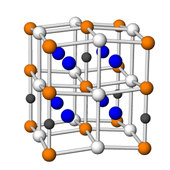Lock
100 MW
Seen via the EVDL:
http://electric-vehicle-discussion-...e-Potion-Number-Fe16N2-tp3338284p3338284.html
http://electric-vehicle-discussion-...e-Potion-Number-Fe16N2-tp3338284p3338284.html
EV Love Potion Number Fe16N2
Posted by brucedp4 on Mar 06, 2011; 08:48pm
EV Motor Magnets Without Rare Earths
http://e.nikkei.com/e/fr/tnks/Nni20110303D03JFN02.htm
March 4, 2011
New Compound Opens Way To EV Magnet Without Rare Earths
TOKYO (Nikkei)--A team of researchers, mainly from Toda Kogyo Corp. and Tohoku University, said Thursday that it succeeded in making a magnetic material without rare-earth metals.
A new material made from iron and nitrogen can be used in electric-vehicle motor magnets.
The material is an ultrafine powder -- made from iron and nitrogen -- measuring tens to hundreds of nanometers in diameter. It can be used in electric-vehicle motor magnets, the researchers say. The goal is to commercialize the compound by 2023 with help from Toyota Motor Corp. and Honda R&D Co.
The team was able to make several tens of grams of the compound while ensuring even quality. But for commercial application, the material must be molded into a magnet by using heat and pressure.
A magnet made of this compound will be "60% more powerful than existing magnets," says professor Migaku Takahashi of Tohoku University. This opens a new frontier in the development of smaller magnets, making it possible to reduce the size of EV motors by 40%
without compromising power.
Existing magnets for EV motors use neodymium, a rare-earth metal mostly produced in China, as well as iron and boron. As prices of neodymium rise, the industry has been seeking an alternative.
[© Nikkei Inc. All rights reserved.]
http://eetweb.com/motors-drives/Fe16N2PMmotors032310/
Scientists find strongest magnet yet; Could Fe16N2 PM motors be next?
Mar 23 2010
Materials physicists from the University of Minnesota have found a super-magnetic material comprising 16 iron atoms and two of nitrogen. An x-ray analysis of the compound showed that six iron atoms are clustered around each nitrogen, with two more located between the two
clusters. The researchers said electrons flowing between the clusters act like they do in ordinary iron, but within the clusters, the electrons tend to be localized, and this increases the magnetism.
The findings were reported at the American Physical Society’s meeting this month.
Researchers say it had been thought since the 1970s that the material, Fe16N2, was extremely magnetic, but no one had ever been able to confirm the theory. Complicating the problem is that Fe16N2 is metastable and tends to form other crystal structures. The Minnesota researchers created a thin film of the material and used x-ray magnetic circular dichroism to measure its magnetization. This technique directly detects the localized electrons, and is thus less sensitive to volume effects than the earlier methods.
But it doesn't look like you'll be buying Fe16N2 PM motors anytime soon. The applications for the material that researchers have in mind are thin-film heads for hard disk drives. And though they have managed to produce samples for research purposes, they say they don't
yet have a way of mass producing the stuff.
The Physorg.com site ran a story on the findings:
http://www.physorg.com/news188458077.html
[© 2011 Penton Media Inc.]

http://linkinghub.elsevier.com/retrieve/pii/S0022459610003270
Journal of Solid State Chemistry
Volume 183, Issue 9, September 2010, Pages 2236-2241
doi:10.1016/j.jssc.2010.07.045
Humidity effects in Fe16N2 fine powder preparation by low-temperature nitridation
Kohetsu Yamanakaa, Yuki Onumaa, Shohei Yamashitaa, Yuji Masubuchia, Takashi Takeda1, a and Shinichi Kikkawa
a Graduate School of Engineering, Hokkaido University, N13W8, Kita-ku, Sapporo 060-8628, Japan
Received 13 April 2010;
revised 25 July 2010;
accepted 27 July 2010.
Available online 4 August 2010.
Abstract
Low-temperature nitridation has been reported to produce ferromagnetic a"-Fe16N2 by ammonia nitridation of a-Fe fine powder, which was obtained from the reduction of vapor-grown ?-Fe2O3. The effects of humidity during this preparation were investigated in the present study. a"-Fe16N2 was inconsistently obtained, and at low yield, from Fe3O4 fine powder (MT-40) prepared from aqueous solution. Reducing the adsorbed water content in the iron oxide starting powder resulted in improved reproducibility of the a"-Fe16N2 yield of the nitridation.
The use of a smaller-diameter reaction tube, less than 25 mm in diameter, enabled more reproducible preparation from vapor-grown v-Fe2O3 powder (CI-30). The reaction yield was further improved by using high-quality ammonia with a water content of =0.05 ppm.
Minimizing the humidity made it possible to obtain a fine powder with a high a"-Fe16N2 content. Enhancement of the magnetization to 210 emu g-1 at room temperature was observed from a nitrided mixture of a"-Fe16N2 with residual a-Fe, compared to 199 emu g-1 for an a-Fe fine powder reduced from y-Fe2O3. However, excess nitrogen and residual
oxygen in the nitrided products reduced the magnetization below the value of a-Fe powder after nitridation. The magnetization was enhanced in nitrided products with a nitrogen content slightly below the stoichiometric amount for a"-Fe16N2.
Graphical abstract
Humidity should be as low as possible to obtain a fine powder with a high a"-Fe16N2 content. An enhancement of magnetization to 210 emu g-1 at room temperature was observed from a nitrided mixture of a"-Fe16N2 with residual a-Fe, compared to 199 emu g-1 for an a-Fe
fine powder reduced from ?-Fe2O3.
Article Outline
1.Introduction
2.Experimental
3.Results and discussion
3.1. Preparation temperature of a"-Fe16N2
3.2. Humidity effects on the preparation
3.3. Magnetic property dependence on nitrogen and oxygen content
4.Conclusion
[Acknowledgments]
References
Corresponding author. Fax: +81 11 706 6739.
1 Present address: National Institute for Materials Science, 1-1
Namiki, Tsukuba, Ibaraki 305-0044, Japan.
Journal of Solid State Chemistry
Volume 183, Issue 9, September 2010, Pages 2236-2241
[© 2011 Elsevier B.V. All rights reserved]
{brucedp.150m.com}

